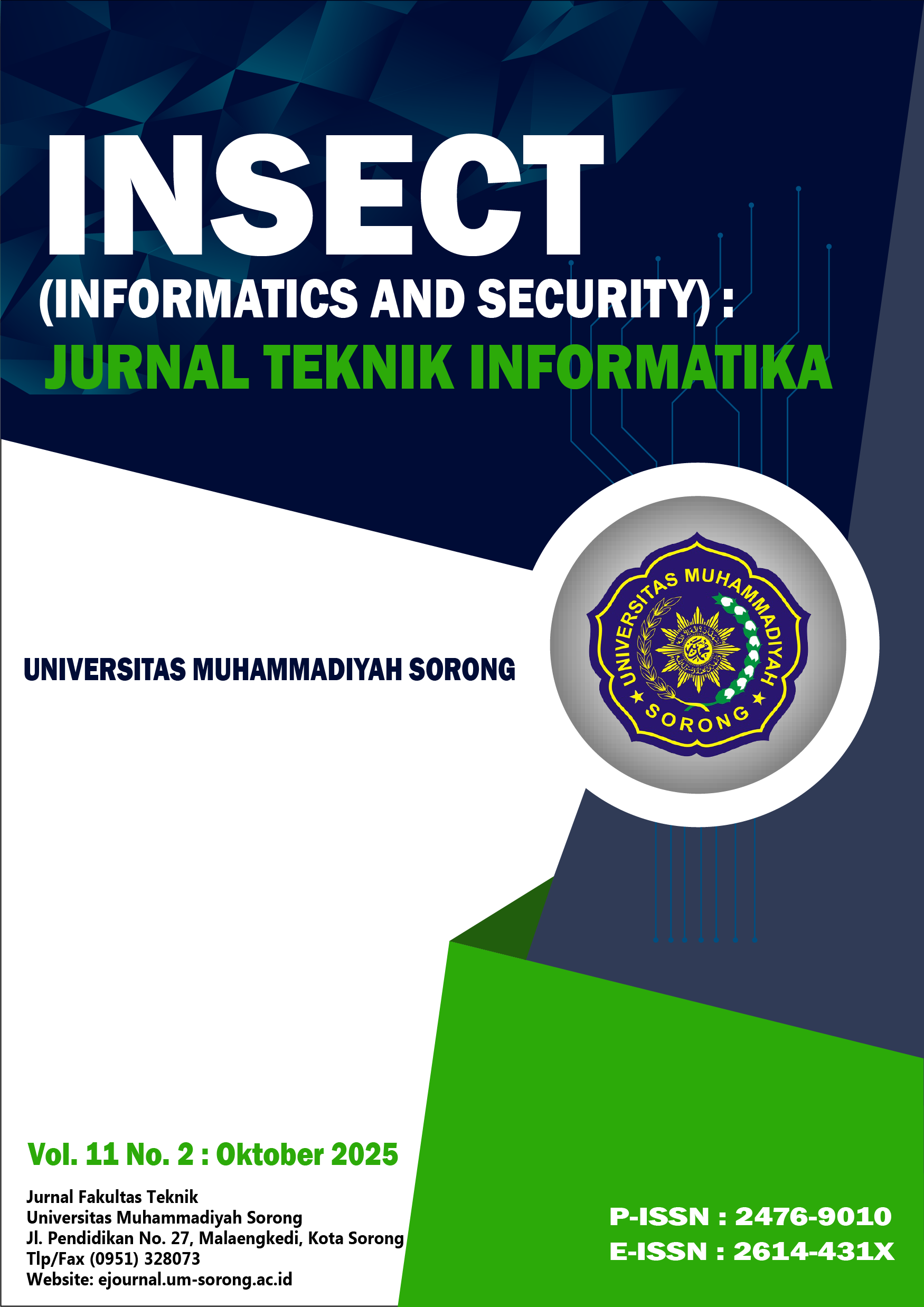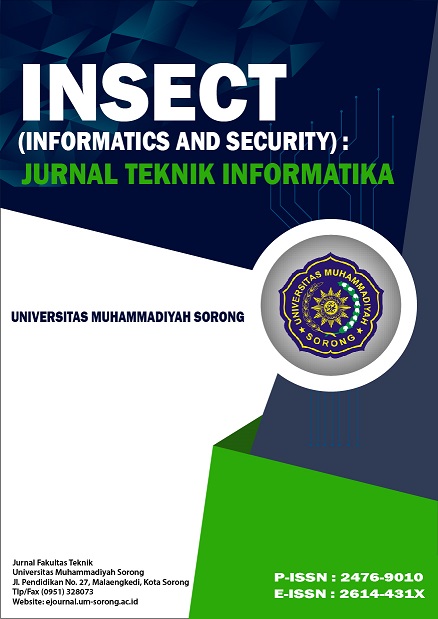Social Assistance Recipient Eligibility Classification Using the K-Nearest Neighbors Method
DOI:
https://doi.org/10.33506/insect.v11i2.4918Keywords:
K-Nearest Neighbors, Classification, Social Assistance, Confusion Matrix, AccuracyAbstract
Social assistance distribution in Indonesia still faces various challenges, including inaccurate recipient data, complex bureaucracy, and lack of transparency, often resulting in misdirected aid. This study aims to optimize the application of the K-Nearest Neighbors (K-NN) method for classifying the eligibility of social assistance recipients by testing several data train-test split ratios and variations of the parameter k. The primary objective is to develop an accurate and reliable classification model to support policy-making in social assistance distribution at Kuto Batu Village, Palembang. The dataset includes citizens' socioeconomic attributes and undergoes preprocessing steps such as data cleaning, encoding, and handling missing values before being applied to the K-NN algorithm. Four data split scenarios are tested—80/20, 70/30, 60/40, and 50/50—to determine the optimal configuration. Evaluation results show model accuracies of 97.44%, 98.30%, 97.10%, and 98.00% for the respective splits. The 70/30 split yields the best performance with 98.30% accuracy, 100% precision, 98% recall, and 98.98% F1-score. This ratio is selected as the optimal configuration due to its balance between sufficient training data for pattern learning and adequate test data for evaluating model generalization. These findings demonstrate that the K-NN method is effective in objectively distinguishing eligible and ineligible recipients and has strong potential as the foundation for a decision support system to improve transparency and targeting accuracy in social assistance programs.
References
[1] K. D. Irianto, “Design of Smart Farm Irrigation Monitoring System Using IoT and LoRA,” J. RESTI (Rekayasa Sist. dan Teknol. Informasi), vol. 6, no. 1, pp. 47–56, 2021.
[2] R. Fadilah, “Bantuan Sosial Sembako dan Bantuan Sosial Tunai,” J. El-Thawalib, vol. 2, no. 3, pp. 167–179, 2021, doi: 10.24952/el-thawalib.v2i3.3992.
[3] I. D. Utami, Pemodelan Sistem. Malang: Media Nusa Creative, 2021.
[4] Fithria and Annisa, “Bansos, demokrasi,dan merawat kemiskinan.” [Online]. Available: https://news.uad.ac.id/bansos-demokrasi-dan-upaya-merawat-kemiskinan%0A
[5] F. P. Lestari, M. Haekal, R. Edmi Edison, F. Ravi Fauzy, S. Nurul Khotimah, and F. Haryanto, “Epileptic Seizure Detection in EEGs by Using Random Tree Forest, Naïve Bayes and KNN Classification,” J. Phys. Conf. Ser., vol. 1505, no. 1, 2020, doi: 10.1088/1742-6596/1505/1/012055.
[6] A. R. Wijaya, I. Lazulfa, M. F. Rizal, and A. Andriani, “Implementasi Metode K-Nearest Neighbor ( Knn ) Untuk Menentukan,” vol. 0, pp. 165–172, 2024.
[7] R. Hamonangan, R. K. Sari, S. Anwar, and T. Hartati, “Klasifikasi Algoritma KNN dalam menentukan Penerima Bantuan Langsung Tunai,” vol. 6, no. 1, pp. 198–204, 2024.
[8] P. Pahrudin and K. Harianto, “Penerapan Algoritma K-Nearest Neighbor Untuk Klasifikasi Warga Penerima Bantuan Sosial,” Build. Informatics, Technol. Sci., vol. 4, no. 3, pp. 1241–1245, 2022, doi: 10.47065/bits.v4i3.2276.
[9] A. Khairi, A. F. Ghozali, and A. D. N. Hidayah, “Implementasi K-Nearest Neighbor (KNN) untuk Mengklasifikasi Masyarakat Pra-Sejahtera Desa Sapikerep Kecamatan Sukapura,” TRILOGI J. Ilmu Teknol. Kesehatan, dan Hum., vol. 2, no. 3, pp. 319–323, 2021, doi: 10.33650/trilogi.v2i3.2878.
[10] P. M. Hasan, N. Ayu, and R. A. Saputra, “Klasifikasi Keringanan Ukt Mahasiswa Uho Menggunakan K-Nearest Neighbor ( KNN ),” vol. 8, no. 6, pp. 11939–11945, 2024.
[11] A. Zulkarnain and A. B. Pohan, “Klasifikasi Penerima Bantuan Usaha Mikro Kecil Dan Menengah (UMKM) Menggunakan Algoritma K-Nearest Neighbors,” Biomaterials, vol. 07, no. 12, pp. 85–90, 2023.
[12] R. Fitra and I. Rusdi, “Penerapan Metode Algoritma K-Nearest Neighbor Menggunakan Rapidminer Studio Pada Klasifikasi Status Sosial Ekonomi Studi Kasus : Kelurahan Kapuk Muara Rt 010 Rw 04,” Smart Comp Jurnalnya Orang Pint. Komput., vol. 11, no. 4, pp. 653–660, 2022, doi: 10.30591/smartcomp.v11i4.4250.
[13] S. R. Cholil, T. Handayani, R. Prathivi, and T. Ardianita, “Implementasi Algoritma Klasifikasi K-Nearest Neighbor (KNN) Untuk Klasifikasi Seleksi Penerima Beasiswa,” IJCIT (Indonesian J. Comput. Inf. Technol., vol. 6, no. 2, pp. 118–127, 2021, doi: 10.31294/ijcit.v6i2.10438.
[14] H. Yozza, N. M. Azizah, L. Yulianti, and I. RAHMI, “The Classification of ‘Program Sembako’ recipients in Payobasung West Sumatra based on the K-nearest neighbors classifier,” J. Nat., vol. 23, no. 2, pp. 83–91, 2023, doi: 10.24815/jn.v23i2.29738.
[15] Nazori Suhandi, Rendra Gustriansyah, and A. Destria, “Klasifikasi Penyakit TBC Menggunakan Metode UMAP dan K-NN,” bit-Tech, vol. 7, no. 3, pp. 843–852, 2025, doi: 10.32877/bt.v7i3.2227.

Downloads
Published
How to Cite
Issue
Section
License
Copyright (c) 2025 Nyimas Siti Rosyad, Herri Setiawan, Muhammad Haviz Irvani

This work is licensed under a Creative Commons Attribution-ShareAlike 4.0 International License.







